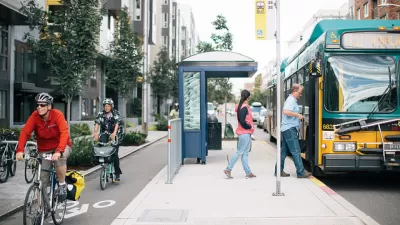The city of Portland will take the momentous step of estimating person trips, rather than car trips, when estimating the impacts of new developments. The decision is another step toward ending the systems of car-centric planning.

Jonathan Maus reports that the Portland City Council "unanimously passed an ordinance (PDF) allowing PBOT to use a methodology that uses 'person trips' – meaning trips made not just by people in cars and trucks but also foot, by bike and in transit vehicles."
According to Maus, "the methodology Portland currently uses is based on the Institute of Transportation Engineers (ITE) Trip Generation Manual [pdf] which [Brian Davis, a transportation analyst at Lancaster Engineering] calls, 'very car-oriented.'" That methodology often greatly overestimates the number of car trips a development will generate, resulting in development fees and infrastructure costs that greatly overcompensate for the needs of cars.
The change of methodology comes against the backdrop of a larger effort by the city to restructure its Transportation System Development Charge (TSDC). According to Maus, however, the implications of the decision to measure person trips could extend even further than the TSDC, when combined with the relatively new skepticism toward level of service as a measure of impact. Maus writes: "If we begin to quantify road users as people doing a variety of things — not just driving a car — than we can start looking at a multi-modal level of service and begin planning for the city we want."
FULL STORY: Beyond cars: City Council votes for ‘person trips’ to make better planning decisions

Alabama: Trump Terminates Settlements for Black Communities Harmed By Raw Sewage
Trump deemed the landmark civil rights agreement “illegal DEI and environmental justice policy.”

Planetizen Federal Action Tracker
A weekly monitor of how Trump’s orders and actions are impacting planners and planning in America.

The 120 Year Old Tiny Home Villages That Sheltered San Francisco’s Earthquake Refugees
More than a century ago, San Francisco mobilized to house thousands of residents displaced by the 1906 earthquake. Could their strategy offer a model for the present?

In Both Crashes and Crime, Public Transportation is Far Safer than Driving
Contrary to popular assumptions, public transportation has far lower crash and crime rates than automobile travel. For safer communities, improve and encourage transit travel.

Report: Zoning Reforms Should Complement Nashville’s Ambitious Transit Plan
Without reform, restrictive zoning codes will limit the impact of the city’s planned transit expansion and could exclude some of the residents who depend on transit the most.

Judge Orders Release of Frozen IRA, IIJA Funding
The decision is a victory for environmental groups who charged that freezing funds for critical infrastructure and disaster response programs caused “real and irreparable harm” to communities.
Urban Design for Planners 1: Software Tools
This six-course series explores essential urban design concepts using open source software and equips planners with the tools they need to participate fully in the urban design process.
Planning for Universal Design
Learn the tools for implementing Universal Design in planning regulations.
Clanton & Associates, Inc.
Jessamine County Fiscal Court
Institute for Housing and Urban Development Studies (IHS)
City of Grandview
Harvard GSD Executive Education
Toledo-Lucas County Plan Commissions
Salt Lake City
NYU Wagner Graduate School of Public Service





























